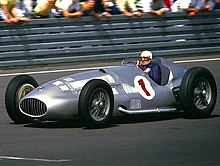Mercedes-Benz W 154
The Mercedes-Benz W 154 was a racing car from Daimler-Benz AG , which in 1938 received a turbocharged 3-liter engine in accordance with the cubic capacity formula that came into effect that year. It was the successor to the Mercedes-Benz W 125 .
General
The car had a forward rails twelve-cylinder - V-engine (type M 163), the two Roots blowers was charged with a pressure of up to 2.2 bar (later two-stage blower); initial power around 450 hp (331 kW) at 8000 rpm (1938). The V-engine was significantly lower than the 8-cylinder in-line engine of the W 125, so that the W 154 was significantly flatter and more aerodynamic than its predecessor. The top speed with the Nürburgring transmission was 310 km / h and almost reached the value of the much more powerful W 125.
The vehicle used about 1 liter of a special fuel per kilometer. That is why the W 154 had a tank capacity of 400 liters. In order to keep the weight distribution of the car even when the fuel supply sank, a tank was installed in the rear and a second (180 liters) in front of the driver or between the cockpit and the engine.
The manual transmission was (as in the W 125) on the rear axle. To ensure that the driver's seat position and the car's center of gravity were as low as possible, the engine was tilted backwards and installed at an angle to the center plane of the vehicle. Therefore, the cardan shaft from the engine to the gearbox could not be placed in the middle, but to the side of the driver's seat.
See also: Silver Arrow
Technical specifications

| Mercedes-Benz W 154 | Technical specifications |
|---|---|
| Motor (type M 163): | Twelve cylinders - V-type engine (60 ° bank angle ) |
| Bore × stroke : | 67 × 70 mm |
| Displacement : | 2962 cc |
| Power: | 353 kW (480 hp) at 7800 rpm |
| Valve control : | two overhead camshafts per cylinder bank , driving through gears ( spur gear ) |
| Valves: | Four per cylinder (2 inlet, 2 outlet) |
| Charge: | two Roots blowers , from 1939 a two-stage blower |
| Lubrication: | Dry sump |
| Cooling : | water |
| Transmission: | 5-speed |
| Chassis : | Tubular frame |
| Front suspension: | Double wishbones with coil springs |
| Rear suspension: | De-Dion axle with longitudinal torsion bars and push struts |
| Shock absorber : | hydraulic shock absorbers |
| Brakes: | hydraulically operated drum brakes |
| Wheelbase : | 2725 mm |
| Track width front / rear: | 1475/1400 mm |
| Dry weight : | approx. 900 kg |
| Top speed: | approx. 310 km / h (with "Nürburgring" translation) |
The technical information in the sources listed below differ slightly.
The success of the W 154
With the drivers Rudolf Caracciola , Hermann Lang and Manfred von Brauchitsch, the car won three of the four Grandes Épreuves at the Grand Prix European Championship in 1938 and Rudolf Caracciola became European champion for the third time. In 1939 , the W 154 also won three times in four Grandes Épreuves. Hermann Lang, who in the same year won the Gran Premio di Tripoli for racing cars in the Voiturette class with the W 165 and was declared European champion . After the war, the W 154 started twice in Buenos Aires (February 18 and 25, 1951) and took second and third place with Lang and Fangio and Kling and Lang.
- Mercedes-Benz W 154 II (1939) - original from the Schlumpf collection
Literature and Sources
- Edler / Roediger: "The German racing vehicles", Fachbuchverlag Leipzig 1990, ISBN 3-343-00435-9
- Schrader: "Silver Arrows - The legendary racing cars 1934 to 1955", Heel Verlag, Königswinter 1995, ISBN 3-89365-428-3
- Cyril Posthumus: "Classic Racing Cars", Hamlyn Publishing Group Limited 1977
Web links
| Vehicle class | 1920s | 1930s | 1940s | ||||||||||||||||
| 6th | 7th | 8th | 9 | 0 | 1 | 2 | 3 | 4th | 5 | 6th | 7th | 8th | 9 | 0 | 1 | 2 | 3 | 4th | |
| Compact class | W 15 (type 170) | ||||||||||||||||||
| W 23 (type 130) | |||||||||||||||||||
| W 30 (type 150) | |||||||||||||||||||
| W 28 (type 170 H) | |||||||||||||||||||
| Middle class | W 02 (type Stuttgart 200) | W 136 / W 149 (types 170 V / 200 V) | |||||||||||||||||
| W 11 (type Stuttgart 260) | W 143 (type 230 n) | ||||||||||||||||||
| W 21 (type 200/230) | W 153 (type 230) | ||||||||||||||||||
| W 138 (type 260 D) | |||||||||||||||||||
| upper middle class | W 03 / W 04 / W 05 (types 300/320/350) | W 18 (type 290) | |||||||||||||||||
| W 10 / W 19 (types 350/370/380) | W 142 (type 320) | ||||||||||||||||||
| W 22 | |||||||||||||||||||
| Upper class | Type 400 & Type 630 | W 24 / W 29 / W 129 (types 500 K / 540 K / 580 K) | |||||||||||||||||
| W 08 (type Nürburg 460/460 K / 500 / type 500 N) | |||||||||||||||||||
| W 07 / W 150 (types 770/770 K) | |||||||||||||||||||
| Sports car | Model K | ||||||||||||||||||
| W 06 (type S / SS / SSK / SSKL) | W 24 / W 29 / W 129 | ||||||||||||||||||
| Off-road vehicle | W 103 (type G1) | W 31 (type G4) | |||||||||||||||||
| W 133 III (type 170 VG) / W 139 (type 170 VL) / W 152 (type G5) | |||||||||||||||||||
| Vans | L 3/4 | L 1000 Express | L 301 | ||||||||||||||||
| L 300 | |||||||||||||||||||







